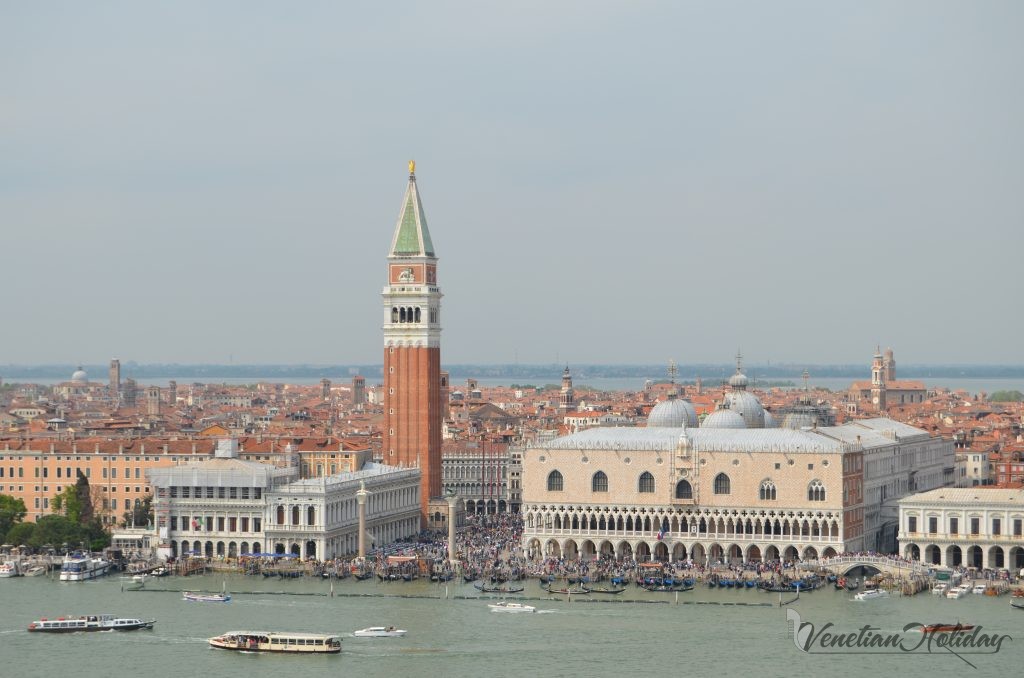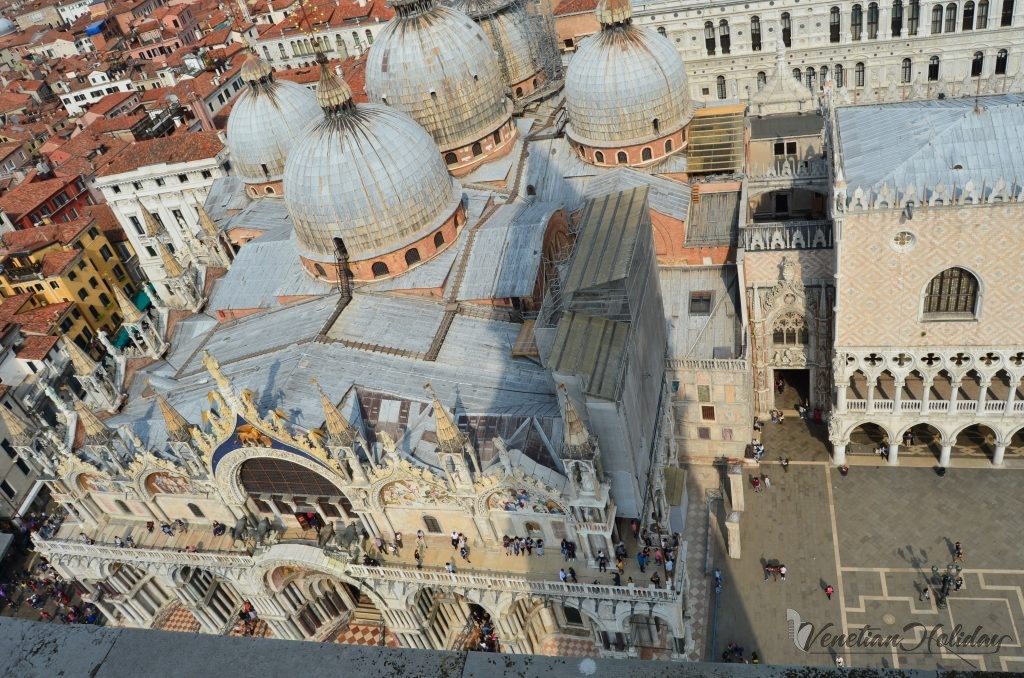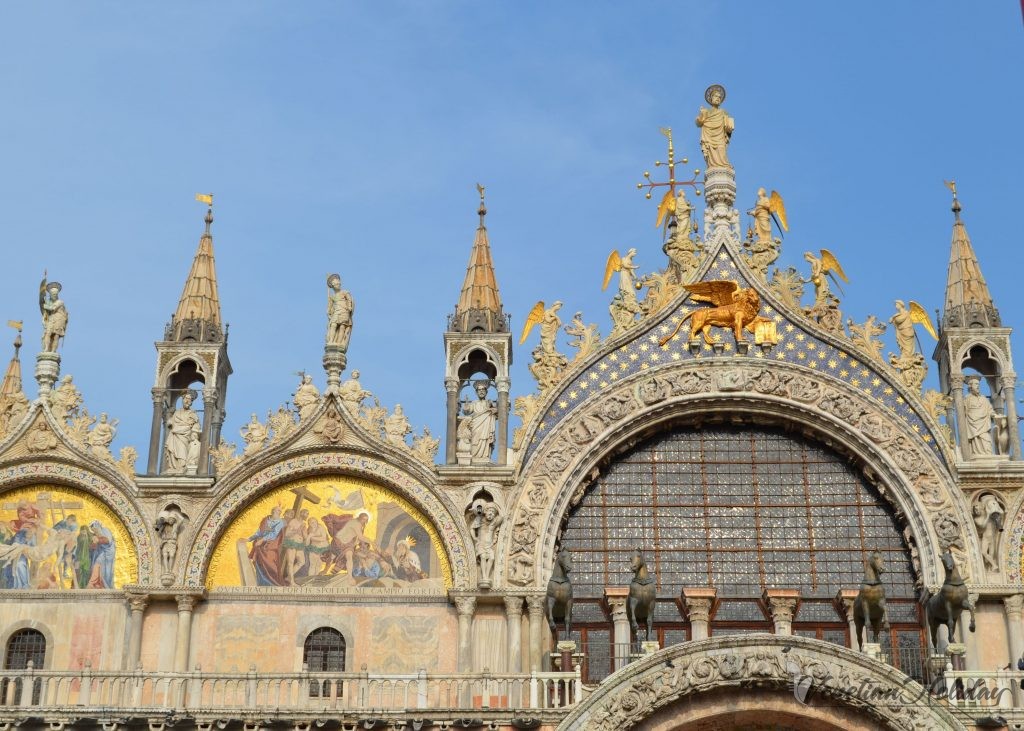The "Must-See" Sites of Venice


St. Mark's Square (Piazza San Marco)
St. Mark’s Square is the only piazza in Venice and arguably the most well known in all of Italy. Millions of people come from all over the world to walk through the square and gaze in wonder at the Basilica of St. Mark and it’s bell tower, the Campanile. The Campanile, rebuilt in 1902 after it's collapse, stands at 310 feet and offers unencumbered views of the whole of Venezia. The view is well worth the wait in line and the elevator ride to the top.
At the eastern end of the square, the Torre dell'Orologio stands over the entrance to the main road leading to the Rialto. The clocktower was built in 1496 and not only tells the time, but also the current moon phase and astrological sign. Every hour the two mechanical bronze Moors at the top ring the giant bell. The north side of the square was built shorly after the clocktower and the south side was completed by 1584. It was Napoleon Bonaparte who ordered the construction of the Western wing, which finally enclosed the area and defined the space as it is today. At night, the plaza becomes something like a dream with candlelight in each window and quartets playing at each of the cafes.
Adjacent to the piazza is the Piazzetta, an open area that lies between the Doge’s Palace and the Library of Marciana. Two massive columns situated at the mouth of the Piazzetta since the 12th century are caped with the Lion of St. Mark and Saint Theodore, Venice’s patron saint prior to St. Mark. In his book Venice, Charles Yriarte writes "Three such shafts were brought from Constantinople; one of them fell into the water at the moment when it was being raised. The two which remained were long left lying on the ground for want of adequate means to set them up." The task was ultimately undertaken by Nicolo Barettieri, the architect of the first Rialto Bridge.
Fun Fact! - On the south promenade of the square you will find Cafe Florian. Opened in 1720, this was Italy's first cafe and the oldest cafe in the world!
Take a look at the selected tours below that feature this magnificent space:
- Unusual Perspectives of St Mark's Museum and Basilica
- Venice Landmarks: Walking Tour Plus St Mark's Basilica and Doge's Palace Tours
- Super Saver: Skip-the-Line Best of Venice Walking Tour and Small Islands in One Day
St. Mark's Basilica
The current Basilica of St. Mark was constructed in various stages. Work began on the current building in 1063 AD after a fire destroyed the first construction in 978 AD. From its consecration in 1094, the church served as the private chapel to the Doge’s Palace until 1807 when it became the seat of the Bishop by order of Napoleon.
The interior of St. Mark’s is decorated with incredible mosaics that reach from the floor to the domes and cast a gold glow over the entire interior. The Basilica’s crypt holds the body of St. Mark which was smuggled out of Alexandria Egypt in 829 AD. It is said that the body withstood the fire of 978 AD because the sarcophagus was encased in the concrete of a pillar for safe keeping during the revolts that ended up destroying the church. Today the body of the Saint rests under an alter in the crypt which is exactly under the high alter of the Basilica.
One of the more famous artistic works of the Bisilica are the Horses of San Marco. The four bronze horses were removed from Constantinople during the 4th Crusade. They remained on top of the grand entrance to the Basilica until Napoleon removed them in 1797 and sent them to Paris. When the French Emperor was exiled the second time to Saint Helena, the quadriga was returned to Venice and remained above the door there until 1982. In the book titled Art & Architecture Venice, Marion Kaminski notes that as the horses were threatened by pollution, “in 1982, the originals were placed in the Museo Marciano, which can now be reached via a narrow stairway from the narthex of the Basilica.” Today replicas stand outside in the place of the original horses.
Entrance to the Basilica is free however personal tours can be arranged which will not only teach you about the Basilica but also skip you to the front of the line so you make the most of your time. Other tours such as the Unusual Perspectives tour will take you to areas off limits to the general public. See tours we have selected that highlight St. Mark’s Basilica.
- SuperSaver:Skip-the-Line Doge's Palace & St Mark Tour, Walking Tour & Grand Canal Cruise
- Legendary Venice St. Mark's Basilica and Doge's Palace
- Unusual Perspectives of St Mark's Museum and Basilica
- Venice Landmarks: Walking Tour Plus St Mark's Basilica and Doge's Palace Tours
- The Splendors of St. Mark's Venice Tour
- Venice Walking Tour plus Skip the Lines Doge's Palace and St Mark's Basilica Tours



The Doge's Palace
Constructed between 1340 and 1424, the Doge’s Palace was the home of the elected Doge of the Republic of Venice as well as the center for the elected councils and public offices. The entire Republic was governed from here. Some of the most incredible features of the palace are:
Porta della Carta -intricately carved entrance to the central courtyard.
Scala dei Giganti (Staircase of Giants) -inauguration ceremonies were carried out below the Lion of St. Mark and the gigantic statues of Neptune and Mercury (by Jacopo Sansovino).
The various Sala (council halls) - beautifully decorated with carved wood and plaster surrounding priceless works of art from masters such as Titian, Tintoretto and Bella.
The Bridge of Sighs connects the Doge's Palace to the prison. See below for more info!
- SuperSaver:Skip-the-Line Doge's Palace & St Mark Tour, Walking Tour & Grand Canal Cruise
- Skip the Line: Doge's Palace Secret Itineraries Tour
- Venice-in-a-Day Combination Tour Package
- Legendary Venice St. Mark's Basilica and Doge's Palace
- and more...
The Bridge of Sighs (Ponte dei Sospiri)
This beautiful bridge with it's intricately carved windows and figureheads is one of the most recognizable features in Venice. The Bridge of Sighs was constructed between 1600 and 1602 in order to provide access from the Doge’s Palace to the newly constructed prison across the Rio dei Palazzo. The name of the bridge is derived from the expressions of the prisoners looking out onto the beauty of Venice as they crossed on their way to and from the prison. The bridge can be seen from the Ponte della Paglia on the lagoon side or via the Ponte de la Canonica from behind. Tours of the Doge’s Palace allow visitors to walk across this magnificent bridge. Specifically, “The Secret Itinerary Tour” allows visitors to trace the steps of Casanova himself who was imprisoned here from July 1755 until his escape in November 1755. He chronicled his escape in "The Story of My Escape" in 1787.


The Rialto Bridge (Ponte de Rialto)
The current bridge at the Rialto is actually the second structure built over the canal at this location. The original wooden bridge collapsed twice during its tenure before being replaced in 1588-1591 by the masterpiece that stands today. One of only three bridges that cross the Grand Canal, the Ponte de Rialto is by far the busiest and most beloved. In the past the bridge served to connect the busy warehouses to the Rialto markets making the flow and distribution of goods into the city free and unrestricted. Today tourists come from all over the world to marvel at its beauty, shop in the stores on the bridge and climb to the top for an unrivaled view of the Grand Canal.
Check out the following tours that feature the Rialto Bridge:
- Private Tour: Venice Rialto Market, San Polo and Frari Church Walking Tour
- Rialto Market Food and Wine Lunchtime Tour of Venice
- Venice Landmarks: Walking Tour Plus St Mark's Basilica and Doge's Palace Tours
San Giorgio Maggiore
San Giorgio Maggiore is the picturesque island across the lagoon from the Doge’s Palace. The island has been inhabited since Roman times but was developed to its current state by Benedictine monks in the 16th century when the church was added to the existing monastery. The Church of San Giorgio Maggiore was designed by Andrea Palladino and is considered one of his greatest buildings. The church holds two priceless works of art by Jacopo Tintoretto; The Last Supper and Gathering of the Manna. Another great treasure of the church is the spectacular vistas the bell tower affords visitors. A short ride up the elevator will reward you with picture perfect views of the Piazzetta, Doge’s Palace and the entire Basin of San Marco. Open year round 9am - 6pm.
If you would like to experience San Giorgio Maggiore first hand, check out the tour we have selected below:
- Venice Cruise by Luxury Motorboat: Grand Canal and Basilica of San Giorgio Maggiore


Fondaco dei Tedeschi
The current structure of the Fondaco dei Tedechi was built from 1505-1508 after a fire destroyed the previous building. This Fondaco served as a large German trading post for the majority of its existence. Goods were unloaded from ships on the Grand Canal into the warehouse space on the first floor. Administrative offices were located on the second floor and living quarters on the third. The building was largely abandoned from the time of Napoleon’s occupation until the city took the Fondaco over for use as Venice’s central post office. In 2008 the building was sold to the Benneton Group who restored the building and turned the structure into a collection of high-end shops. Tourists have the ability to walk through the building and see the inside architecture of a typical Fondaco.
Must Do! - The 4th floor offers access to a platform on the roof with stunning views of the Grand Canal and the Rialto. All access is free but to ensure admittance, you should reserve a time slot before you go.
The Arsenal
Just as the architectural foundations of Venice were built on solid wood pilings, the foundations of Venetian power were built on her Arsenale and the fleet of ships it produced. One should not go to Venice without paying a visit to the Campo Arsenale to peer back in time through the towers at her former might. This shipyard was the envy of the entire world and the speed at which war galleys were produced was unrivaled. In his book titled “Venice”, Charles Yriarte notes, “when King Henri III of France came to see the arsenal in 1574, while he was attending a banquet in the Great Hall, in two hours a galley was put together and launched.” While the Arsenale is largely abandoned today, it serves as an ever present reminder of the glory of Venice.
Fun Fact! - While in the Campo Arsenale, you will find four statues of lions. The largest lion to the left of the gate was sculpted in the 4th century BC and brought from Piraeus Greece (the harbor of Athens) when Venice conquered the Peloponnese in 1687.


The Grand Canal (Canalazzo)
Over the centuries the who’s who of Venetian aristocracy built elegant palaces (palazzo) along this main thoroughfare. Many wealthy traders would keep watch from the terraces in the upper living quarters of their palazzo as their trading ships ferried goods back from the far corners of the world to the store rooms on the lower levels of their home. Taking a trip along this ancient waterway through the center of Venice is a must. Guided tours on a traditional Venetian water Taxi can be found below. You can also make your own self guided tour by purchasing a Vaparetto (water bus) ticket and catching the #1 from Vallaresso (next to St. Marks) and riding to Ferrovia or Piazzale Roma.
- Venice Cruise by Luxury Motorboat: Grand Canal and Basilica of San Giorgio Maggiore
- Kayak Tour of Venice
- Gondola Ride of Venice's Grand Canal - 30 min
- Private Tour: Venice Gondola Ride Including the Grand Canal - 60 min
- Gondola and Gala Dinner in a Venetian Palace
